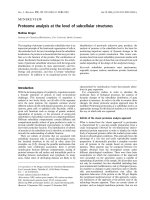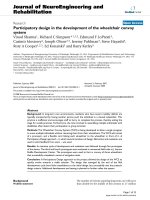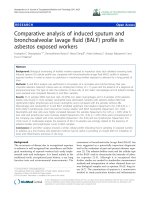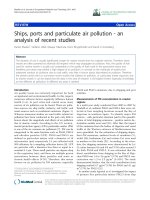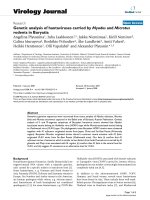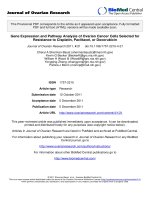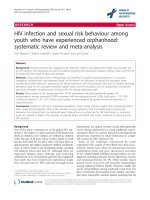báo cáo hóa học:" Editorial Analysis and Signal Processing of Oesophageal and Pathological Voices" pot
Bạn đang xem bản rút gọn của tài liệu. Xem và tải ngay bản đầy đủ của tài liệu tại đây (443.2 KB, 4 trang )
Hindawi Publishing Corporation
EURASIP Journal on Advances in Signal Processing
Volume 2009, Article ID 283504, 4 pages
doi:10.1155/2009/283504
Editorial
Analysis and Signal Processing of Oesophageal and
Pathological Voices
Juan Ignacio Godino-Llorente,
1
Pedro G
´
omez-Vilda (EURASIP Member),
2
and Tan Lee
3
1
Department of Circuits & Systems Engineering, Universidad Polit
´
ecnica de Madrid, Carretera Valencia Km 7, 28031, Madrid, Spain
2
Department of Computer Science & Engineering, Universidad Polit
´
ecnica de Madrid, Campus de Montegancedo, Boadilla del Monte,
28660, Madrid, Spain
3
Department of Electronic Engineering, The Chinese University of Hong Kong, Shatin, New Territories, Hong Kong
Correspondence should be addressed to Juan Ignacio Godino-Llorente,
Received 29 October 2009; Accepted 29 October 2009
Copyright © 2009 Juan Ignacio Godino-Llorente et al. This is an open access article distributed under the Creative Commons
Attribution License, which permits unrestricted use, distribution, and reproduction in any medium, provided the original work is
properly cited.
1. Introduction
Speech not only is limited to the process of communication
but also is very important for transferring emotions, it is a
small part of our personality, reflects situations of stress, and
has a cosmetic added value in many different professional
activities. Since speech communication is fundamental to
human interaction, we are moving toward a new scenario
where speech is gaining greater importance in our daily lives.
On the other hand, modern styles of life have increased the
risk of experiencing some kind of voice alterations. In this
sense, the National Institute on Deafness and Other Commu-
nication Disorders (NIDCD) pointed out that approximately
7.5 million people in the United States have trouble using
their voices [1]. Even though providing statistics on people
affected by voice disorders is a very difficult task, as reported
in [2], it is underlined that between 5 and 10% of the US
working population have to be considered as using their
voice in an intensive way. In Finland, these statistics are
estimated close to 25%. Still in [2], the conclusions point
out that the voice is the primary tool for about 25 to 33% of
the working population. While the case of teachers has been
largely studied in literature [2, 3], singers, doctors, lawyers,
nurses, (tele-)marketer people, professional trainers, and
public speakers also make great demands on their voices and,
consequently, they are prone to experiencing voice problems
[1, 4–6]. Therefore, in addition to medical consequences
in daily life (treatment, rehabilitation, etc.), some voice
disorders have also severe consequences regarding profes-
sional (job performance, attendance, occupation changes)
and economical aspects but also far from being negligible,
regarding social activities, and interaction with others [2–4].
However, despite many years of effort devoted to
developing algorithms for speech signal processing, and
despite the elaboration of automatic speech recognition and
synthesis systems, our knowledge of the nature of the speech
signal and the effects of pathologies is still limited. In spite of
this, voice scientists and clinicians take profit of the simple
models and methods developed by speech signal processing
engineers to build up their own analysis methods for the
assessment of disorders of voice (DoV).
Yet, the limitations of existing models and methods are
felt in both areas of expertise, that is, speech signal processing
applications and assessment of DoV. For example, the
intervals within which signal model parameters must remain
constant to represent signals with timbre that is perceived
as natural are unknown. Moreover, such efficient control
of voice quality has important applications in modern text-
to-speech synthesis systems (creating new synthetic voices,
simulating emotions, etc.). Voice clinicians, on the other
hand, have expressed their disappointment with regard to the
performance of existing methods for assessing voice quality,
with a special focus on the forensic implications. Major issues
with current methods include robustness against noise,
consistency of measurements, interpretation of estimated
features from a speech production point of view, and
correlation with perception.
So there exist a need for new and objective ways to evalu-
ate the speech, its quality, and its connection with other phe-
nomena, since the deviation out of the patterns considered of
2 EURASIP Journal on Advances in Signal Processing
normality can be correlated with many different symptoms
and psychophysical situations. As previously commented,
research to date in speech technology has focussed the effort
in areas such as speech synthesis, recognition, and speaker
verification/recognition. Speech technologies have evolved to
the stage where they are reliable enough to be applied in
other a reas. In this sense, acoustic analysis is a noninvasive
technique which is an efficient tool for the objective support
and the diagnosis of DoV, the screening of vocal and
voice diseases (and particularly their early detection), the
objective determination of vocal function alterations, and the
evaluation of surgical as well as pharmacological treatments
and rehabilitation. Its application should not be restricted to
the medical area alone, as it may also be of special interest
in forensic applications, the control of voice quality for voice
professionals such as singers, speakers, the evaluation of the
stress, and so forth.
In addition, digital speech processing techniques pay a
special role dealing with oesophageal voices. The quality of
voice and the functional limitations of the laryngectomized
patients remain an important challenge for improving their
quality of life.
On the other hand, the acoustic analysis reveals as a
complementary tool to other methods of evaluation used
in the clinic based on the direct observation of the vocal
folds using videoendoscopy. Therefore, a deeper insight into
the voice production mechanism and its relevant parameters
could help clinicians to improve prevention and treatment
of DoV. In this sense, and in order to contribute filling in this
gap, during the last ten years, links and co-operation among
different research fields have become effective to define and
set up simple and reliable tools for voice analysis. As a result,
there exists a joint initiative to the European level de voted to
the research in this field: the COST 2103 Action [7], funded
by the European Science Foundation, is a joint initiative of
speech processing teams and the European Laryngological
Research Group (ELRG). The main objective of this action is
to improve voice production models and analysis algorithms
with a view to assessing voice disorders, by incorporating
new or previously unexploited techniques, with recent the-
oretical developments in order to improve modelling of nor-
mal and abnormal voice production, including substitution
voices. This is an interdisciplinary action that aims to foster
synergies between various complementary disciplines as a
promising way to efficiently address the complexity of many
current research and development problems in the field of
DoV. In particular, the progress in the clinical assessment
and enhancement of voice quality requires the cooperation
of speech processing engineers and voice clinicians.
The aim of this special issue is to contribute with a step-
forward filling in the aforementioned gaps.
2. Summary of the Issue
For this special issue, 31 submissions were received. After a
difficult review process, 12 papers have been accepted for
publication. The accepted articles address important issues
in speech processing and applications on oesophageal and
pathological voices.
The articles in this special issue cover the following
topics: methods of voice quality analysis based on fre-
quency and amplitude perturbation and noise measure-
ments; development of acoustic features to detect, classify,
or discriminate pathological voices; classification techniques
for the automatic detection of pathological voices; automatic
assessment of voice quality; automatic word and phoneme
intelligibility in pathological voices; analyzing and assess-
ing the speech of cognitive impaired people; automatic
detection of obstructive sleep apnoea from the speech;
robust recognition of dysarthric speakers; and, automatic
speech recognition and synthesis to enhance the quality of
communication.
In this issue, two papers describe the methods of voice
quality analysis based on frequency and amplitude pertur-
bation (i.e., jitter and shimmer) and noise measurements.
Although these measurements have been widely applied in
the state of the art for a long time, still present some
drawbacks, and further research is needed in this field.
The jitter value is a measure of the irregularity of a
quasiperiodic signal and is a good indicator of the presence
of pathologies in the larynx such as vocal fold nodules or
a vocal fold polyp. The paper by Silva et al. focuses on the
evaluation of different methods found in the state of the art
to estimate the amount of jitter present in speech signals.
Also, the authors proposed a new jitter measurement.
Given the irregular nature of the speech signal, each jitter
estimation algorithm relies on its own model making a direct
comparison of the results very difficult. For this reason, in
this paper, the evaluation of the different jitter estimation
methods is targeted on their ability to detect pathological
voices. The paper shows that there are significant differences
in the performance of the jitter algorithms under evaluation.
In addition, with respect to the classic acoustic measure-
ments, since the calculations of Harmonics-to-Noise Ratio
(HNR) in voiced signals are affected by general aperiodicity
(like jitter, shimmer, and waveform variability), the paper by
Ferrer et al. develops a method to reduce the shimmer effects
in the calculation of the HNR. The authors proposed an
ensemble averaging technique that has been gradually refined
in terms of its sensitivity to jitter, waveform variability,
and required number of pulses. In this paper, shimmer is
introduced in the model of the ensemble average and a
formula is derived which allows the reduction of shimmer
effects in HNR calculation.
On the other hand, several articles presented in this
issue reported works about detecting, classifying, or dis-
criminating pathological voices. Three of them focus on the
development of acoustic features.
The paper by Dubuisson et al. presents a system devel-
oped to discriminate normal and patholog ical voices. The
proposed system is based on features inspired from voice
pathology assessment and music information retrieval. The
paper uses two features (spectral decrease and first spectral
tristimulus in the Bark scale) and their correlation, leading
to correct classification rates of 94.7% for pathological voices
and 89.5% for normal ones. Moreover, the system provides a
normal/pathological factor giving an objective indication to
the clinician.
EURASIP Journal on Advances in Signal Processing 3
Ghoraani and Krishnan propose another methodology
for the automatic detection of pathological voices. The
authors proposed the extraction of meaningful and unique
features using adaptive time-frequency distribution (TFD)
and nonnegative matrix factorization (NMF). The adaptive
TFD dynamically tracks the nonstationarity in the speech,
and NMF quantifies the constructed TFD. The proposed
method extracts meaningful and unique features from the
joint TFD of the speech, and automatically identifies and
measures the abnormality of the signal.
In addition, Carello and Magnano evaluated in their
paper the acoustic properties of oesophageal voices (EVs)
and tracheo-oesophageal voices (TEPs). For each patient,
some acoustic features were calculated: fundamental fre-
quency, intensity, jitter, shimmer, and noise-to-harmonic
ratio. Moreover, for TEP patients, the tracheostoma pressure
at the time of phonation was measured in order to obtain
information about the “in vivo” pressure necessary to open
the phonatory valve to enable speech. The authors reported
noise components between 600 Hz and 800 Hz in all patients,
with a harmonic component between 1200 Hz and 1600 Hz.
Besides, the TEP have better acoustic characteristics and
a lower standard deviation. To investigate the correlation
between the pressure and the TEP voice signals, the cross
spectrum based on the Fourier transform was evaluated. The
most important and interesting result pointed out by this
analysis is that the two s ignals reported equal fundamental
frequency and the same harmonic components for each TEP
subject considered.
Two more papers in this issue discussed different classifi-
cation techniques for the automatic detection of pathological
voices. The paper by Kotropoulos et al. compares two
distinct pattern recognition approaches: the detection of
male subjects who are diagnosed with vocal fold par alysis
against male subjects who are diagnosed as normal; the
detection of female subjects who are suffering from vocal
fold edema against female subjects w ho do not suffer from
any voice pathology. Linear prediction coefficients extracted
from sustained vowels were used as features. The evaluation
was carried out using a Bayes classifier with Gaussian
class conditional probability density functions with equal
covariance matrices.
Fredouille et al. address the important task of voice
quality assessment. They proposed an original back-and-
forth methodology involving an automatic classification
system as well as knowledge of the human experts (machine
learning experts, phoneticians, and pathologists). The auto-
matic system was validated with a dysphonic corpus,
rated according to the GRBAS perceptual scale by an
expert jury. The analysis showed the interest of the (0–
3000) Hz frequency band for this classification problem.
Additionally, an automatic phonemic analysis underlined
the significance of consonants and more surprisingly of
unvoiced consonants for the same classification task. Sub-
mitted to the human experts, these observations led to a
manual analysis of unvoiced plosives, which highlighted a
lengthening of voice onset time (VOT) according to the
dysphonia severity validated by a preliminary statistical
analysis.
Four more papers deal with the analyzing and assessing
of different types of impaired or disordered speech.
The paper by Saz e t al. presents the results in the analysis
of the acoustic features (formants and the three supraseg-
mental features: tone, intensity, and duration) of the vowel
production in a group of young speakers suffering different
kinds of speech impairments due to physical and cognitive
disorders. A corpus with unimpaired children’s speech is
used to determine the reference values for these features in
speakers without any kind of speech impairment within the
same domain of the impaired speakers; that is, 57 isolated
words. The signal processing to extract the formant and
pitch values is based on a linear prediction coefficient (LPC)
analysis of the segments considered as vowels in a hidden
Markov model- (HMM-) based Viterbi forced alignment.
Intensity and duration are also based in the outcome of
the automated segmentation. As main conclusion of the
work, it is shown that intelligibility of the vowel production
is lowered in impaired speakers even when the vowel is
perceived as correct by human labelers. The decrease in
intelligibility is due to a 30% of increase in confusability in
the formants map, a reduction of 50% in the discriminative
power in energy between stressed and unstressed vowels, and
a 50% increase of the standard deviation in the length of
the vowels. On the other hand, impaired speakers kept good
control of tone in the production of stressed and unstressed
vowels.
Likewise, it is commonly acknowledged that word or
phoneme intelligibility is an important criterion in the
assessment of the communication efficiency of a pathological
speaker. Middag et al. developed a system based on automatic
speech recognition (ASR) technology to automate and
objectify the intelligibility assessment. This paper presents
a methodology that uses phonological features, automatic
speech alignment (based on acoustic models trained with
normal speech), context-dependent speaker feature extrac-
tion, and intelligibility prediction based on a small model
that can be trained on pathological speech samples. The
experimental evaluation of the new system revealed that
the root mean squared error of the discrepancies between
perceived and computed intelligibilities can be as low as 8
on a scale of 0 to 100.
Morales and Cox modelled the errors done by a
dysarthric speaker and attempt to correct them using two
techniques: a) a set of “metamodels” that incorporate a
model of the speaker’s phonetic confusion-matrix into the
ASR process; b) a cascade of weighted finite-state transducers
at the confusion-matrix, word, and language levels. Both
techniques attempt to correct the errors made at the phonetic
level and make use of a language model to find the best
estimate of the correct word sequence. The experiments
showed that both techniques outperform standard adapta-
tion techniques.
Pozo et al. proposed the use of ASR techniques for the
automatic diagnosis of patients with severe obstruc tive sleep
apnoea (OSA). Early detection of severe apnoea cases is
important so that patients can receive early treatment, and
an effective ASR-based detection system could dramatically
reduce medical testing time. Working with a carefully
4 EURASIP Journal on Advances in Signal Processing
designed speech database of healthy and apnoea subjects,
they describe an acoustic search for distinctive apnoea voice
characteristics. The paper also studies abnormal nasalization
in OSA patients by modelling vowels in nasal and nonnasal
phonetic contexts using Gaussian mixture model (GMM)
pattern recognition on speech spectra.
Finally, the paper by Selouani et al. proposes the use of
assistive speech-enabled systems to help both French and
English speaking persons with various speech disorders. The
proposed assistive systems use ASR and speech synthesis
in order to enhance the quality of communication. These
systems aim at improving the intelligibility of pathologic
speech making it as natural as possible and close to the
original voice of the speaker. The resynthesized utterances
use new basic units, a new concatenating algorithm, and
a grafting technique to correct the poorly pronounced
phonemes. The ASR responses are uttered by the new speech
synthesis system in order to convey an intelligible message
to listeners. An improvement of the perceptual evaluation of
the speech quality (PESQ) value of 5% and more than 20%
was achieved by the speech synthesis systems dealing with
substitution disorders (SSD) and dysarthria, respectively.
To conclude, this special issue aims at offering an
interdisciplinary platform for presenting new knowledge in
the field of analysis and signal processing of oesophageal
and pathological voices. From these papers, we hope that
the interested reader will find useful suggestions and further
stimulation to carry on research in this field.
Acknowledgments
The authors are extremely grateful to all the reviewers
who took time and consideration to assess the submitted
manuscripts. Their diligence and their constructive cr iticism
and remarks contributed greatly to ensure that the final
papers have conformed to the high standards expected in
this publication. Moreover, we would like to thank all the
authors who submitted papers to this special issue for their
patience during the always hard and long reviewing process,
especially to those that unfortunately had no opportunity
to see their work published. Last, but not least, we would
like to thank the Editor in-Chief and the Editorial Office of
EURASIP Journal on Advances in Signal Processing for their
continuous efforts and valuable support.
Juan Ignacio Godino-Llorente
Pedro G
´
omez Vilda
Tan L ee
References
[1] National Institute on Deafness and Other Communication Dis-
orders (NIDCD), ANR2008—Document B/anglais VoxAcCom
Page 6/39, October 2009, />statistics/vsl.asp.
[2] La voix. Ses Troubles Chez Les Enseignants, INSERM, 2006.
[3] American Speech-Language-Hearing Association, October
2009, />[4] E. Smith, M. Taylor, M. Mendoza, J. Barkmeier, J. Lemke, and
H. Hoffman, “Spasmodic dysphonia and vocal fold paralysis:
outcomes of voice problems on work-related functioning,”
Journal of Voice, vol. 12, no. 2, pp. 223–232, 1998.
[5] Medline Plus, October 2009, med-
lineplus/voicedisorders.html.
[6] J.Kreiman,B.R.Gerratt,G.B.Kempster,A.Erman,andG.S.
Berke, “Perceptual evaluation of voice quality: review, tutorial,
and a framework for future research,” Journal of Speech and
Hearing Research, vol. 36, no. 1, pp. 21–40, 1993.
[7] M. Kob and P. H. Dejonckere, ““Advanced voice function
assessment”—goals and activities of COST action 2103,”
Biomedical Signal Processing and Control, vol. 4, no. 3, pp. 173–
175, 2009.
